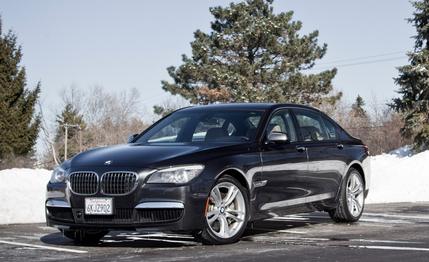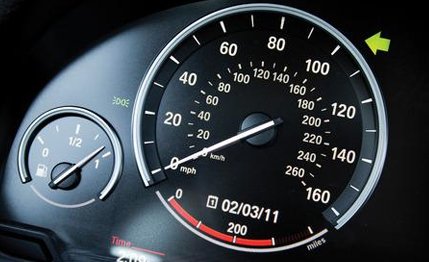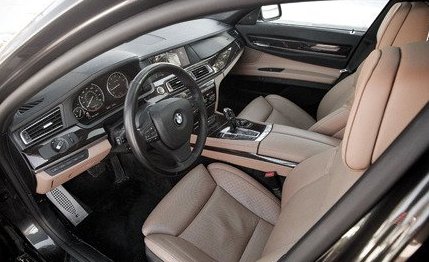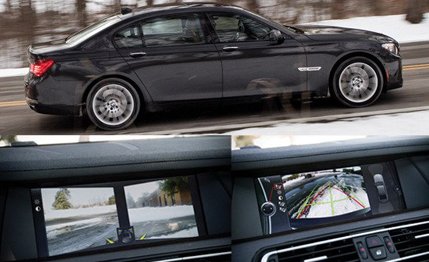
 Long-Term Road Test
Long-Term Road Test




At 2:17 a.m. on June 6, 2010, an 800-yard-wide tornado packing winds of up to 135 mph ripped through the tiny hamlet of Dundee, Michigan. In its wake were damaged homes, uprooted trees, and utility poles scattered about like toothpicks. Amid all the windblown rubble surrounding the Dundee home of our copy chief, Cora Weber, sat our long-term BMW 750Li, amazingly unscathed and undisturbed. Fortune had finally smiled on the $119,080 luxury sedan. Previous spins of Fortuna’s wheel hadn’t gone as well for this particular car. After all, it should have landed in the hands of a caring, wealthy owner instead of the greasy, disease-ridden mitts of your humble C/D staff.


Like a big shiny Christmas present, BMW delivered our long-wheelbase 750Li xDrive in late December 2009 for a 40,000-mile evaluation. Our love of huge back seats and mobile status symbols notwithstanding, we requested a 7-series for a higher purpose: to see if the new car was indeed a return to form after the notoriously troublesome, overly complicated, over-the-top, overwrought, fourth-generation 7-series. Is that chapter of 7-series history over?
Styling-wise, simplicity appears to be back at BMW. But it’s only skin-deep. Greater-than-ever complexity and luxury lurk beneath the fifth-generation 7er, especially when equipped like our long-termer.
Bursting at the door skins with $29,600 of technology, safety, appearance, and luxury options, our 750Li was the magazine’s most-expensive long-term car ever. BMW sent us every available package: M Sport with 20-inch wheels ($7800), Luxury Seating and Cold Weather ($2800), Luxury Rear Seating ($3700), Rear Entertainment ($2200), Premium Sound ($2000), Convenience ($1700), Driver Assistance ($1350), and Camera ($750). BMW didn’t stop there, adding radar-based cruise control ($2400), night vision with pedestrian detection ($2600), a head-up display ($1300), satellite radio ($350), and “ceramic controls” ($650), an appearance option that trims the iDrive, volume, and ventilation controls in a black finish. This level of decadence usually ends in someone losing their head, figuratively or literally.


It didn’t take long to realize that we didn’t like or want most of the extras. For the majority of the test, the blind-spot-detection and lane-departure-warning systems that come as part of the Driver Assistance package remained off so as to silence their pestering beeps. For the same reason, we typically turned off the collision warning that comes bundled with the radar-based cruise control. A few drivers switched off the head-up display after realizing that it disappeared behind polarized sunglasses. Night vision, here an infrared camera that looks in front of the car for pedestrians or animals, allowed us to see in the dark, but it required the driver to monitor the screen at the center of the dashboard instead of the road. Deputy editor Daniel Pund called it “spectacularly distracting.” Another editor asked, “With xenon headlights this good, who needs infrared?”
Escaping the overly protective auspices of the active cruise control proved impossible. “Can we please have a button to shut off the radar portion of the cruise control?” asked senior editor Tony Swan. “Even in its most-aggressive setting, it holds the car a long way back from the car ahead. Maintaining a constant speed is nearly impossible.”


We would have been content to eat our 7-series cake without all of the frosting. What we really liked about the 750Li is all there at the $89,480 base price. Every 750Li comes with a 400-hp, 4.4-liter twin-turbo V-8. It pulled our 4980-pound limo from 0 to 60 in 5.1 seconds when new (5.3 seconds after 40,000 miles). Smooth and willing to rev, this turbocharged engine has turbo-less immediacy. Though it might be smaller than the previous 7-series’ naturally aspirated 4.8-liter, the downsizing hasn’t improved fuel economy. City mileage dropped from 15 mpg to 14, and the highway number went from 23 to 21 and down to 20 with xDrive all-wheel drive. Over the course of 40,000 miles, our 750Li xDrive burned premium at a rate of 18 miles per gallon.
An appetite for fuel didn’t stop the 7-series from becoming the office’s road-trip vehicle of choice. “Provided you have the time, a 750Li is a tempting alternative to flying,” commented former technical director Dave VanderWerp. First-class accommodations, from the spacious interior to the standard front seats that bend to your will, helped make short work of 1000-mile trips to New York and Virginia. Traveling by 7-series may take longer than flying, but that’s more of a speed-limit problem. At 70 mph, our 750Li is only 65 decibels away from complete silence, and it doesn’t get much louder from 70 mph to 100. “Cruising at 85 mph is too easy, and if there weren’t a head-up display, I’d be going 100 mph. Right car, wrong country,” wrote technical editor K.C. Colwell.
During the six months of the year when Michigan resembles Antarctica, we appreciated the heated steering wheel and seats, and especially the xDrive. A weak and dribbling windshield-washer spray, possibly in need of Flomax, proved to be the only part that wasn’t winter-ready. New to the 7-series, BMW’s xDrive all-wheel-drive system allocates nearly all of the engine’s power to the rear wheels under most conditions to maintain rear-wheel-drive handling characteristics. Should the rear tires slip, an electronically controlled clutch pack sends power to the front wheels. The main benefit is extra traction under acceleration.
Stopping and cornering in the slippery stuff was another matter, so we replaced the 20-inch Goodyears with a set of Pirelli -Winter 270 Sottozero Serie II run-flat tires on 19-inch wheels (19-inch winter tires are more readily available). The Pirellis introduced an annoying vibration at highway speeds. Three attempts to balance the tires didn’t fix the problem, which pointed to an issue with the Sottozeros themselves. We returned the defective tires, and Pirelli sent us a second set, which cured the shakes. On the Pirelli rubber, the 7-series’ traction and secure handling on snow and ice led associate online editor David Gluckman to quip, “This car could probably groom Colorado ski runs.”
Unfortunately, our tire problems weren’t limited to wintertime. Riding on 20-inch wheels, the Goodyear run-flats have little in the way of sidewalls. A 4980-pound curb weight, sidewalls that are more membrane than scarp, and scabby pavement resulted in three irreparably damaged front tires. Each replacement cost $389.
Near the end of our test (31,500 miles), we swapped out both rear Goodyears when a misaligned suspension chewed the inside of both tires’ treads to their cords. Since our local dealer didn’t have an alignment rack suitable for this car, it took a few weeks to get the 750Li repaired, at a cost of $302. The replacement rear tires were a not-insubstantial $429 each.
We also shelled out $2529 for a new aluminum hood after large irreparable dents mysteriously appeared at about 10,000 miles. A leading theory involves actress Tawny Kitaen writhing provocatively on the hood to Whitesnake’s magnum opus, “Here I Go Again.”


Regular maintenance for the 7-series costs nothing, at least for the length of the four-year or 50,000-mile warranty. The onboard computer calculates the service intervals and called us in for the first oil change at 16,100 miles. The car requested a second oil change, adding a few more inspections than the first, at 34,691 miles. During that second service, we complained that the transmission had shown a tendency to slam into first gear while the car was coasting to a stop. The problem was intermittent and could not be re-created by our dealer’s technicians.
In addition to those visits, we had three unscheduled service stops that were covered under warranty. The key-fob battery died unusually early at 1330 miles. At 5502 miles, the dealer diagnosed and extinguished a check-engine light caused by an elevated amount of alcohol in the fuel. And when the driver’s-seat controls stopped responding at 7623 miles, the car went back to the shop for a “seat calibration.”
A $119,080 BMW limousine is more car than many of us can afford or use. The 7-series seems to be okay with that. Improvements in design keep the staggering level of technology from overwhelming or annoying the driver. If you’re still not happy, there’s almost always an off switch.
With this 7-series, you can dial in as little or as much technology as you desire, and the car complies. After indulging us for 13 months, our 750Li xDrive should have enough good karma in reserve to survive another tornado.